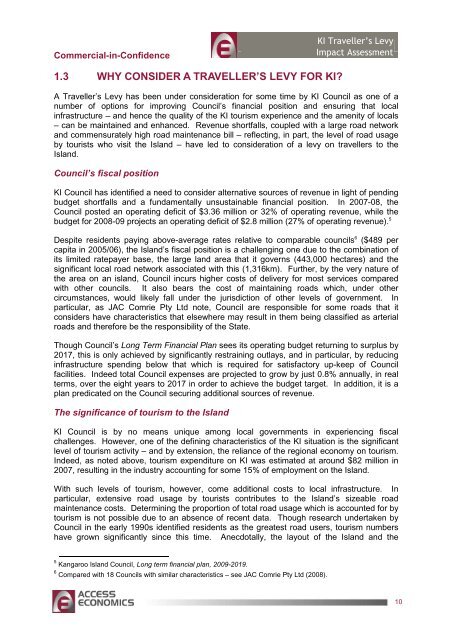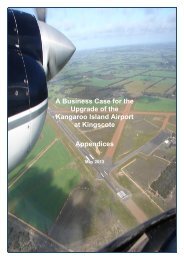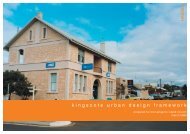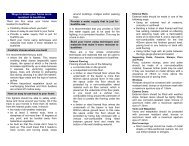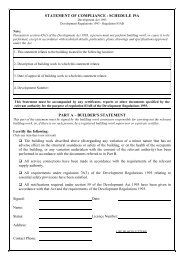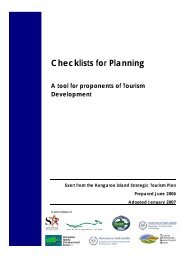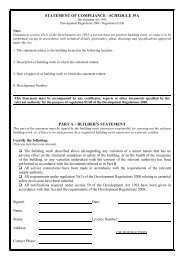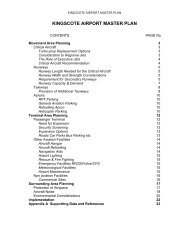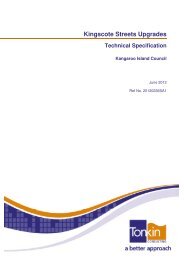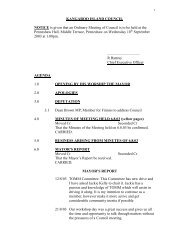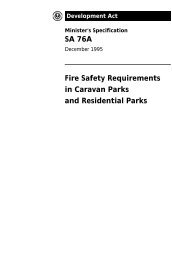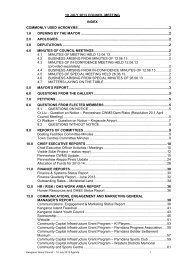KI Traveller's Levy Economic Impact Assessment - Kangaroo Island ...
KI Traveller's Levy Economic Impact Assessment - Kangaroo Island ...
KI Traveller's Levy Economic Impact Assessment - Kangaroo Island ...
Create successful ePaper yourself
Turn your PDF publications into a flip-book with our unique Google optimized e-Paper software.
Commercial-in-Confidence<br />
<strong>KI</strong> Traveller’s <strong>Levy</strong><br />
<strong>Impact</strong> <strong>Assessment</strong><br />
1.3 WHY CONSIDER A TRAVELLER’S LEVY FOR <strong>KI</strong><br />
A Traveller’s <strong>Levy</strong> has been under consideration for some time by <strong>KI</strong> Council as one of a<br />
number of options for improving Council’s financial position and ensuring that local<br />
infrastructure – and hence the quality of the <strong>KI</strong> tourism experience and the amenity of locals<br />
– can be maintained and enhanced. Revenue shortfalls, coupled with a large road network<br />
and commensurately high road maintenance bill – reflecting, in part, the level of road usage<br />
by tourists who visit the <strong>Island</strong> – have led to consideration of a levy on travellers to the<br />
<strong>Island</strong>.<br />
Council’s fiscal position<br />
<strong>KI</strong> Council has identified a need to consider alternative sources of revenue in light of pending<br />
budget shortfalls and a fundamentally unsustainable financial position. In 2007-08, the<br />
Council posted an operating deficit of $3.36 million or 32% of operating revenue, while the<br />
budget for 2008-09 projects an operating deficit of $2.8 million (27% of operating revenue). 5<br />
Despite residents paying above-average rates relative to comparable councils 6 ($489 per<br />
capita in 2005/06), the <strong>Island</strong>’s fiscal position is a challenging one due to the combination of<br />
its limited ratepayer base, the large land area that it governs (443,000 hectares) and the<br />
significant local road network associated with this (1,316km). Further, by the very nature of<br />
the area on an island, Council incurs higher costs of delivery for most services compared<br />
with other councils. It also bears the cost of maintaining roads which, under other<br />
circumstances, would likely fall under the jurisdiction of other levels of government. In<br />
particular, as JAC Comrie Pty Ltd note, Council are responsible for some roads that it<br />
considers have characteristics that elsewhere may result in them being classified as arterial<br />
roads and therefore be the responsibility of the State.<br />
Though Council’s Long Term Financial Plan sees its operating budget returning to surplus by<br />
2017, this is only achieved by significantly restraining outlays, and in particular, by reducing<br />
infrastructure spending below that which is required for satisfactory up-keep of Council<br />
facilities. Indeed total Council expenses are projected to grow by just 0.8% annually, in real<br />
terms, over the eight years to 2017 in order to achieve the budget target. In addition, it is a<br />
plan predicated on the Council securing additional sources of revenue.<br />
The significance of tourism to the <strong>Island</strong><br />
<strong>KI</strong> Council is by no means unique among local governments in experiencing fiscal<br />
challenges. However, one of the defining characteristics of the <strong>KI</strong> situation is the significant<br />
level of tourism activity – and by extension, the reliance of the regional economy on tourism.<br />
Indeed, as noted above, tourism expenditure on <strong>KI</strong> was estimated at around $82 million in<br />
2007, resulting in the industry accounting for some 15% of employment on the <strong>Island</strong>.<br />
With such levels of tourism, however, come additional costs to local infrastructure. In<br />
particular, extensive road usage by tourists contributes to the <strong>Island</strong>’s sizeable road<br />
maintenance costs. Determining the proportion of total road usage which is accounted for by<br />
tourism is not possible due to an absence of recent data. Though research undertaken by<br />
Council in the early 1990s identified residents as the greatest road users, tourism numbers<br />
have grown significantly since this time. Anecdotally, the layout of the <strong>Island</strong> and the<br />
5 <strong>Kangaroo</strong> <strong>Island</strong> Council, Long term financial plan, 2009-2019.<br />
6 Compared with 18 Councils with similar characteristics – see JAC Comrie Pty Ltd (2008).<br />
10


